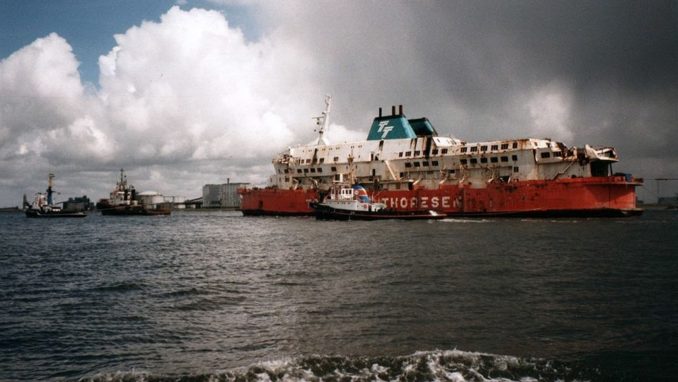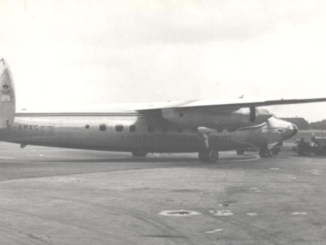
Archief Ranter (The original uploader was AirSafetyGuy at English Wikipedia.), CC BY-SA 1.0, via Wikimedia Commons
Ed. This was sent to me in 2018 by Moscow Fred, sadly he was never able to finish it. RIP Fred. I was reminded of it by the documentary on The Herald of Free Enterprise last night, which I haven’t seen yet but I thought you might like to compare what MF says below and the doco. It’s certainly different from what you will read on Wiki, where crew are blamed – not saying there weren’t errors by the crew but MF contends that The Herald of Free Enterprise wouldn’t have sunk that night given the weather conditions but for Townsend Thoresen’s refusal to invest in the ship’s safety. They appear to have gotten away with corporate manslaughter, but I wonder if the below was known.
The Zeebrugge Disaster on Ch 5
* * *
It dawned on me early on that newspapers put their own spin on their content. I soon learnt to ‘read between the lines’, automatically putting filters onto everything that was presented to me as ‘the unvarnished truth’. My epiphany, as to the true nature of the Vultures of Fleet Street came in early March 1987, just days after the Herald of Free Enterprise capsized outside Zeebrugge harbour.
A little history first
The ‘Spirit’ class (Spirit of Free Enterprise, Herald of …, and Pride of…), came into operation in January 1980 to serve on the Dover to Calais route. To this end, Calais Chamber of Commerce had built double decked Ro-ro ramps so that both decks could be discharged, then loaded, at the same time. This increase in activity meant employing an extra deck officer to oversee the increased activity.
All three vessels continued on the Dover Calais route for three years when Townsend Thoresen expressed a desire to use one of them on the Dover to Zeebrugge route during the winter months, as a ‘Refit replacement’ They also wanted to lose the extra deck officer as, according to them, he would be surplus to requirements. The fact that the ‘extra’ deck officer was essential to all safety roles seemed not to bother them that much.
It soon became obvious that turnarounds in Zeebrugge were going to be a problem. No. 11 berth in Zeebrugge was a single ramp berth and, the ramp could not reach the top deck around high water.
To help this, the vessel had to fill two fwd. ballast tanks with sea water, 110 tons to be precise. This took time with the installed ballast pumps. One and a half hours, meaning that the last part of the inward voyage to Zeebrugge was in a bow down configuration, not conducive to good navigation, especially after entering the shallower water past the A1bis buoy, the vessel would take wild sheers and required superb helmsmanship to stay on track.
All three ships in the class had requested High capacity ballast pumps, so that ballasting need not start until inside the outer harbour walls, and that de-ballasting be complete before leaving the safe harbour environs. These requests had been knocked back by TT marine dept. on the grounds of cost.
It is my contention, and of others, that had the HoFE been equipped with these High capacity pumps, she would have been on an even keel as she exited the harbour, not bow down ready to shovel up the bow wave. She would never have capsized and, that she could have returned to Dover with the bow doors open on that fateful night. The sea was calm and any ingress through the bow door would have been dealt with by the car deck scuppers.
I arrived in Zeebrugge in the early hours, 12 hours after the capsize, escorting the Captain’s wife. We found him in the St. Jan hospital, close to death, his core temperature having dropped to 23°C. The Hospital car park was a seething mass of Media vans from all over the world, the reception areas thronging with press types, all clamouring for information. The wards where survivors were being treated had security staff on the entrances and, brown paper taped over the windows so that photographers couldn’t take pictures. It was like a siege. Some photographers had been caught trying to climb the laundry chutes to gain access. I have to take my hat off to the hospital staff for managing under such duress.
One reporter managed to blag his way into the room where Mark Stanley, the assistant bosun, was recovering. He told Mark that he was from Townsend Thoresen to got him to recount his story, which was splashed all over the papers/TV the next day. Bastards.
We were put up in a local hotel by the Hospital authorities, (Not by TT you’ll note) along with The Snr. Master and a few others, tasked by TT with helping where possible (accompanying relatives around the morgue was not a popular detail). That evening, a few of us were sat at the bar chatting when it was noticed that a female close by was scratching her thigh, one of our number strode over, pulled up her skirt to reveal a carbonless copy pad. She had been recording our conversation in shorthand. She was told in no uncertain terms to Fuck-off and her pad was taken from her.
This war went on for the whole time that Captain Lewry was in the St. Jan hospital. Eventually he was considered fit to return to the UK……………….
© Moscow Fred M.M. (Rtd.) 2018



